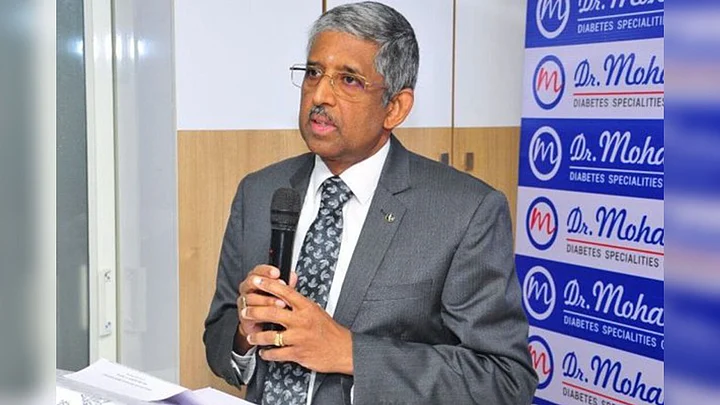Recently published in Journal of Nutrition, the study reveals how adding pistachios to a daily diet could significantly improve metabolic health in people with prediabetes—a discovery that could influence how India tackles its growing diabetes burden. Dr. V. Mohan, one of India’s foremost diabetologists and researchers, sheds light on the findings of a landmark clinical trial led by the Madras Diabetes Research Foundation (MDRF), conducted with the support of the American Pistachio Growers.
Why pistachios before a meal? The science explained
Nuts, especially pistachios, are more than just a crunchy snack—they offer significant health benefits, particularly for people with prediabetes. Dr. V. Mohan, one of India’s leading diabetologists, explains that pistachios are high in protein, fiber, and monounsaturated fatty acids (MUFA), while being low in carbohydrates. This nutritional combination gives them high satiety value, meaning they help you feel full for longer and naturally reduce the intake of less healthy foods. Consuming about 30 grams of pistachios—roughly a handful—an hour before meals has been shown to fill the stomach and reduce the portion size of carbohydrate-rich staples like rice, chapatis, and puris. According to Dr. Mohan, this simple dietary habit leads to a series of positive outcomes: reduced calorie intake from refined carbohydrates, improved blood sugar regulation, lowered cholesterol and triglyceride levels, and even a visible reduction in waist circumference. “Essentially, it primes the stomach with protein and healthy fats, reducing post-meal overeating,” he explains. While similar benefits have already been documented in people with diabetes, this clinical trial specifically focused on prediabetic individuals, aiming to intervene before the onset of the disease. The findings offer a hopeful, evidence-based dietary strategy to curb the growing burden of diabetes.
Inside the landmark clinical trial
In a landmark study conducted by the Madras Diabetes Research Foundation (MDRF), 120 individuals with prediabetes, a stage where blood sugar levels are elevated but not yet in the diabetic range, were enrolled and divided into two groups. The intervention group, comprising 60 participants, consumed pistachios before meals, while the control group (also 60 participants) continued their regular diet without any nuts.
Over a period of 2–3 months, the research team monitored several key health markers, including blood glucose levels, cholesterol, triglycerides, waist circumference, body weight, inflammation markers, and real-time glucose readings using Continuous Glucose Monitoring (CGM).
The results were compelling: the pistachio group showed reduced waist circumference, improved cholesterol and triglyceride levels, better post-meal glucose control as confirmed by CGM, and a modest drop in HbA1c levels. “Almost all cardiometabolic risk factors improved in the pistachio group compared to the control group,” noted Dr. V. Mohan. These significant findings were published in The Journal of Nutrition.
Pistachios: A preventive strategy for young people too
One of the study’s most critical aspects is its focus on young people with prediabetes—a demographic that is often overlooked.
“Prediabetes is reversible, but only if you take action early,” Dr. Mohan stresses. “If you don’t, it progresses to diabetes.”
While the study did not include long-term follow-up, the short-term data was promising. Improvements in glucose levels, cholesterol, triglycerides, and weight suggest that small dietary tweaks can prevent long-term health complications.
Dr. Mohan believes pistachios can help break the myth that nuts are fattening or unhealthy.
“Nuts are nutrient-dense, not junk food. We must teach young people to replace fried snacks with healthier options like fruits, vegetables, and nuts,” he says.
Replacing junk food with pistachios: A simple lifestyle change
India’s youth are increasingly turning to processed, carbohydrate-heavy snacks—a trend that fuels both obesity and diabetes.
“Junk foods are high in trans fats, saturated fats, salt, and sugar. They’re calorie-dense but nutrient-poor,” Dr. Mohan warns.
Pistachios offer a smart alternative.
“They don’t need added salt or sugar. Raw nuts are healthy and tasty as they are,” he advises. “Instead of reaching for a samosa or jalebi at 5 pm, try a handful of pistachios.”
Interestingly, Dr. Mohan points out that the Health Ministry recently flagged traditional fried snacks like jalebi and samosa as unhealthy, making this substitution both a health-conscious and socially responsible choice.
The power of global collaboration
Although the project received funding from the American Pistachio Growers, the research was independently designed, executed, and published by the team at the Madras Diabetes Research Foundation (MDRF). The study also brought together an impressive consortium of global experts, including renowned professors Walter Willett and Frank Hu from the Harvard T.H. Chan School of Public Health, frequent nutrition research collaborator Dr. Shilpa Bhupathiraju, and Professor Jordi Salas from Spain, a leading authority on nut research. “This partnership combined Harvard’s nutritional science, Professor Salas’s knowledge of nuts, and MDRF’s clinical research in India. Together, we filled important research gaps,” says Dr. Mohan. Such international collaborations are instrumental in producing high-quality research that has the potential to influence public health policies not just in India, but around the world.
Dr. Mohan’s one-line advice: Just start
Building healthier habits doesn’t have to be complicated. Swapping junk food for nuts and fruits is a low-cost, high-impact step toward better health. It’s a shift that could transform India’s fight against diabetes, improve national fitness levels, and foster a culture of prevention rather than cure.
“These are natural, minimally processed foods with no side effects,” says Dr. Mohan. “If made affordable and accessible, small lifestyle changes like this could change the health of our nation.”
